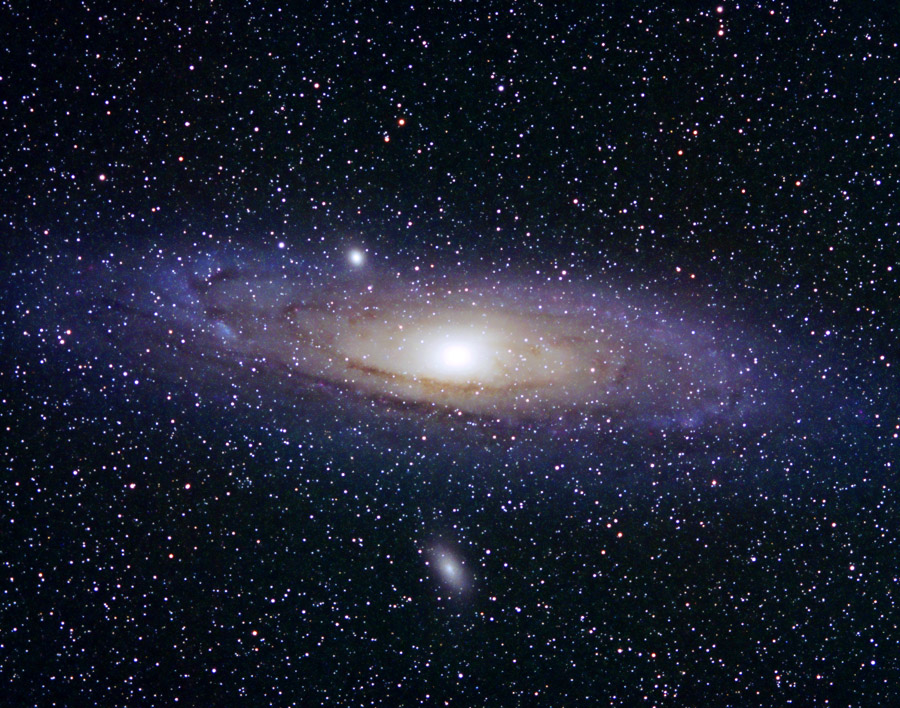 |
Craig White's Literature Courses Terms / Themes Extra-Terrestrial Life |
 |
Extraterrestrial
life?
Statistics say yes
Experience says no, but experience limited
Earth’s sun in arm of Milky Way galaxy: 200 billion stars, 100,000 light years in diameter
If we were to launch expeditionary forces of such a fantastic rate that an expedition reached a new star in our galaxy every hour of the day and night, and we kept up this rate of exploration year after year, in 10 million years we would have visited fewer than half the stars in the Milky Way Galaxy.
Population of universe, 100 billion major galaxies
How much life?
Upper end < given sheer numbers, un-likelihood of being unique: Milky Way, 10,000-1 million advanced societies (Carl Sagan, SETI project)
New minority position: complex life rare
Earth is special: big moon necessary for geological development,
Big planet like Jupiter necessary to attract away killer comets and asteroids, etc. (Hale-Bopp)
Position in “hinterlands” also protects from bombardment, radiation
Counter: opportunistic nature of life
Outcome: raises the stakes, intellectually and morally for survival of life on planet
But even if low range, likelihood of some life out there is great
At least as different from us as we are from the Cro-Magnon people in House of Bones
"soap scum"?
varieties
of alien contact: changes in species & environment
movies & TV create limits on imagination: need actors, can only change human form so much
so all aliens tend to have 2 arms, 2 legs, head, 2 eyes
embellishments: wrinkles, pointed ears, etc.
SETI
Search for Extra-Terrestrial Intelligence (popularized at
Cornell University by Carl Sagan)
assignments
Extraterrestrial
life?
Statistics say yes--our sun is a standard star in an unremarkable spot in a normal galaxy among billions of others > no observable reason why we're special
Experience says no life besides earth--no single example of "alien contact" that everyone agrees to (compare ghosts; media distorts), but experience is limited
Earth’s sun located in arm of Milky Way galaxy: 200-400 billion stars, giant galaxy
"Milky Way" observable beyond city lights--band of hazy light that stretches across the sky
100,000 light years in diameter
Local group: 3 large & 30 smaller galaxies
Andromeda is Milky Way's "twin galaxy" or "sister galaxy"--both are spiral galaxies
but Andromeda is bigger, largest in local group of galaxies, 2.9 million light years away



If we were to launch expeditionary forces of such a fantastic rate that an expedition reached a new star in our galaxy every hour of the day and night, and we kept up this rate of exploration year after year, in 10 million years we would have visited fewer than half the stars in the Milky Way Galaxy.
>
Population of universe, 100 billion major galaxies
Age of universe: 12-20 billion years
How much life?
Normal Galaxies (University of Alabama Astronomy)
facts, beautiful truths, but nearly anyone can live without them
convergence of images, metaphors, and scales of divinity with those of cosmos
but we can even live without that, more or less
Stories make the possibilities personal . . . .
How does the unknown become known? (look for metaphors)
"alien" < Latin "alius" or "other" (compare "alias")
The self defines itself by the other
What do the aliens reveal about us?
How successfully do the stories get beyond the "War of the Worlds" model seen in Independence Day in which aliens are automatically apocalyptic terrorists?
New York Times, April 29, 2007
The Basics
Just 120 Trillion Miles From Home
by Dennis Overbye
How soon till we can get to the Goldilocks planet? Don’t cash in your frequent flier miles yet.
Astronomers announced last week that they had found what might be the first habitable planet outside the solar system. Known poetically as Gliese 581c, the new planet is only five times as massive as the Earth and inhabits a sweet zone around a dim red star in Libra where it is neither too hot nor too cold for liquid water. The star and its retinue of planets are only 20 light years away. “We could go there,” enthused Dimitar Sasselov, an astronomer at the Harvard-Smithsonian Center for Astrophysics, noting that 20 light years is next door in a galaxy 100,000 light years across. But he was speaking for the very, very long term. However near cosmically, the Gliese planet is still about 120 trillion miles away. Voyager 1, now leaving the solar system at a speed of about 39,000 miles per hour, would need more than 300,000 years to travel that far.
Physicists and engineers point out, however, that it is possible to attain much higher speeds with spacecraft that undergo a gentler but steady acceleration throughout the trip, rather than getting a short violent boost at the beginning like Voyager and current rockets do. Lawrence Krauss, a physicist at Case Western Reserve University, and author of “The Physics of Star Trek,” said that a ship that could maintain an acceleration equivalent to the gravity felt on Earth would attain a velocity of half the speed of light in three months.
The technology for that much oomph is nowhere in sight, but NASA has experimented with gentler versions like solar sails, in which the spacecraft is propelled by sunlight, or ion drives, pioneered on a spacecraft named Deep Space 1, which visited a comet in 2001, in which high-energy particles do the propelling. This year a new spacecraft, Dawn, will use ion propulsion to begin a cruise around the asteroid belt. But even ion drives have to carry prohibitive amounts of fuel to reach the stars, said Marc Rayman of the Jet Propulsion Laboratory, and Dawn’s project system engineer.
It would take Dawn 10,000 days and 5,000 pounds of propellant to get up to 150,000 miles per hour, which is only .02 percent of the speed of light, “which is nothing,” said Dr. Rayman.
“That’s an illustration of how daunting this travel is,” he said. “The distances are vast, the challenges are extraordinary.”
“I don’t have any doubt that humankind will eventually have the technology to send spacecraft that distance,” he said, adding, “I have no idea how it will be done.”
Dr. Sasselov said that in the long run, in order to survive planetary catastrophes, we would want to make the trip, by whatever means.
“We don’t have to go next year or even in the next 20 years,” Dr. Sasselov said. But eventually, he said, “if we figure out our human affairs down on here on Earth, we’ll want to be moving along.”
![]()
—x
[ ]x